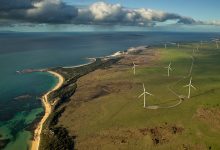Hydro Tasmania has engaged in a new round of lobbying for the state’s ambitious “Battery of the Nation” proposal, arguing that “deep storage” of cheap wind and solar offers the lowest cost and most resilient solution for a renewables based grid.
The state-owned hydro generator this week unveiled a series of “white papers” and analyses that look at the benefits of “deep storage” such as the vast pumped hydro scheme and new transmission links it proposes, and it questions some of the modelling by the Australian Energy Market Operator in its Integrated System Plan, which it argues relies too much on a set of assumptions that may not turn out to be right.
Hydro Tasmania is keen for two new links to the mainland, known as the Marinus Project, to be built by TasNetworks that will deliver 1,500MW of additional capacity to Victoria, supplied by a range of new wind farms in Tasmania, and possibly wind and solar resources in Victoria, and stored in a new pumped hydro facility in Tasmania of around 600-800MW.
The idea has the full support of the Tasmania Liberal government, which has set a target of 200 per cent renewables by 2040, to encourage more wind farms, and more storage, so it can export the surplus clean energy to the mainland.
The new analyses and white papers released by Hydro Tasmania are designed for several audiences – the court of public opinion in Tasmania and elsewhere, but more importantly the experts that are preparing the final draft of the current ISP, and the regulators who have started the long process of considering the case for the new transmission line.
That’s where the economics and the modelling could prove crucial. Hydro Tasmania argues that the link is easily the best option for Victoria as it contemplates an electricity grid faced with the impending and possibly rapid closures of more brown coal generator.
It says the first link – hope for by 2027 – is the cheapest option (see graph above), because the increased capacity of 750MW means it can better use its existing hydro facilities, which it says not fully utilised.
A second link, maybe built in 2028 or 2029 – would require additional pumped hydro capacity of 600-800MW, at a cost of around $1 billion, but would still deliver a cheaper option than any alternatives based in Victoria – according to its estimates.
The arguments put forward by Hydro Tasmania follow a similar, if less extreme, assessment put forward by Snowy Hydro, the federal government owned utility that seems destined to go ahead with the Snowy 2.0 pumped hydro scheme despite concerns from a wide range of energy experts about its economic and environmental viability.
It says that analysis of a “conceptual storage operation” over the last 4-5 years “shows that short duration storages (i.e. batters) perform much worse in reality compared with deep storages of 12 or more hours. Longer duration storages will help manage the risk of future scarcity and limit the need for duplication.
“The Marinus project depends on being able to accurately model how hydro systems respond to the market,” says Chris Gwynne, who is leading the project. “The technology stacks still shows you power of harnessing that system. Only deep storage is able to operate this way.”
Hydro Tasmania says deep storage will be required to manage the uncertainty around supply, particularly if the coal fleet is retired up to 10 years earlier than currently forecast, as some suggest.
The reports argue that pumped hydro schemes, like the battery of the nation project, are the “safest” options in an industry undergoing rapid transition, and where there are so many variables, including in market design.
“Our latest analysis shows that Tasmania has the deep storage the future market needs, and we can deliver new energy supply at costs lower than other known market options,” CEO Steve Davy says in comments accompanying the reports.
“Combining our significant hydropower and pumped hydro capacity with low cost wind and solar givesTasmania a strong competitive advantage, and Tasmania stands ready to support the energy market transition. These projects will make an important contribution to the state’s renewable energy target of producing 200 per cent of current needs by 2040. This objective will see Tasmania double its renewable production.
Davy says that deep storage can provide cost-competitive, reliable back-up to efficiently support Australia’s energy transformation as wind and solar become more prevalent. And he says deep storage is more resilient to future market uncertainty, being able to supply energy for days at a time if needed, to ensure the stable and reliable electricity that customers expect.
“The green light for the state’s first pumped hydro development and more interconnection will mean a huge injection of investment and jobs to Tasmania. This reinforces the need to keep progressing Battery of the Nation and Marinus Link.”
The two transmission links will likely cost around $3 billion, with another $1 billion for the pumped hydro scheme – Hydro Tasmania has narrowed down the potential sites to three on the north west and west coast, with more needed from private investors for additional wind farms in Tasmania, or even wind and solar farms in Victoria which could find an additional market export their power over those links to charge the “battery”.











